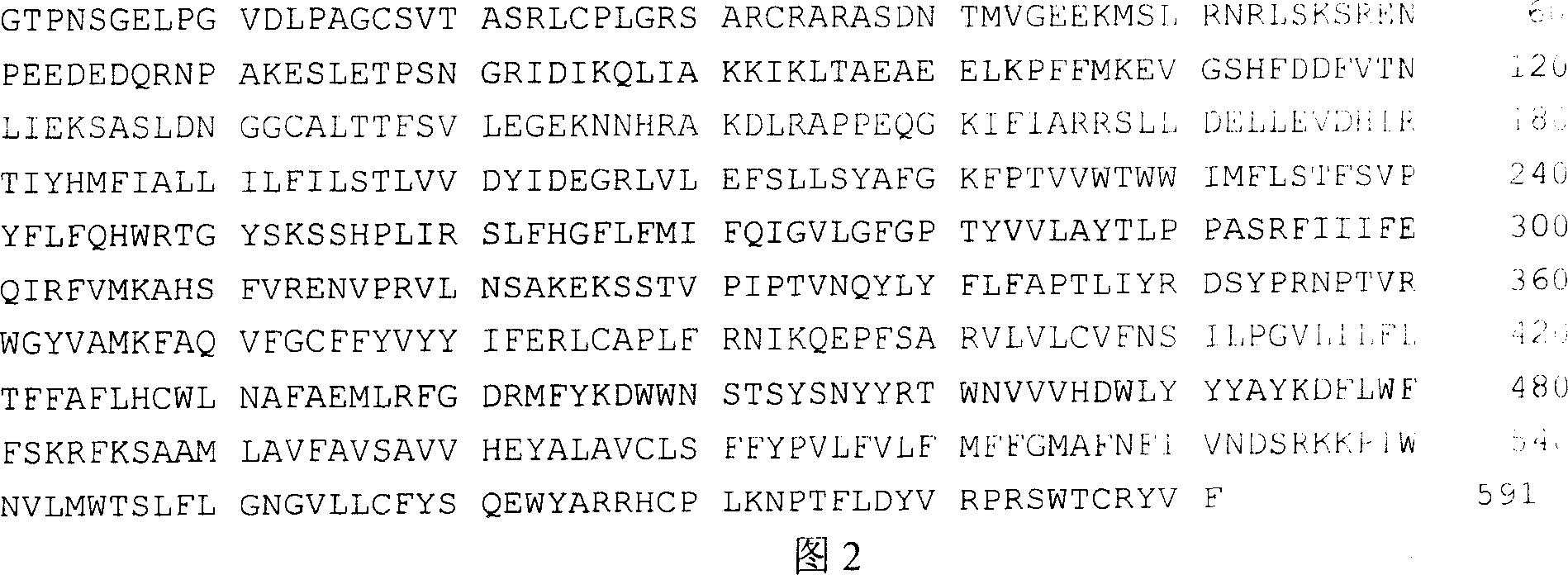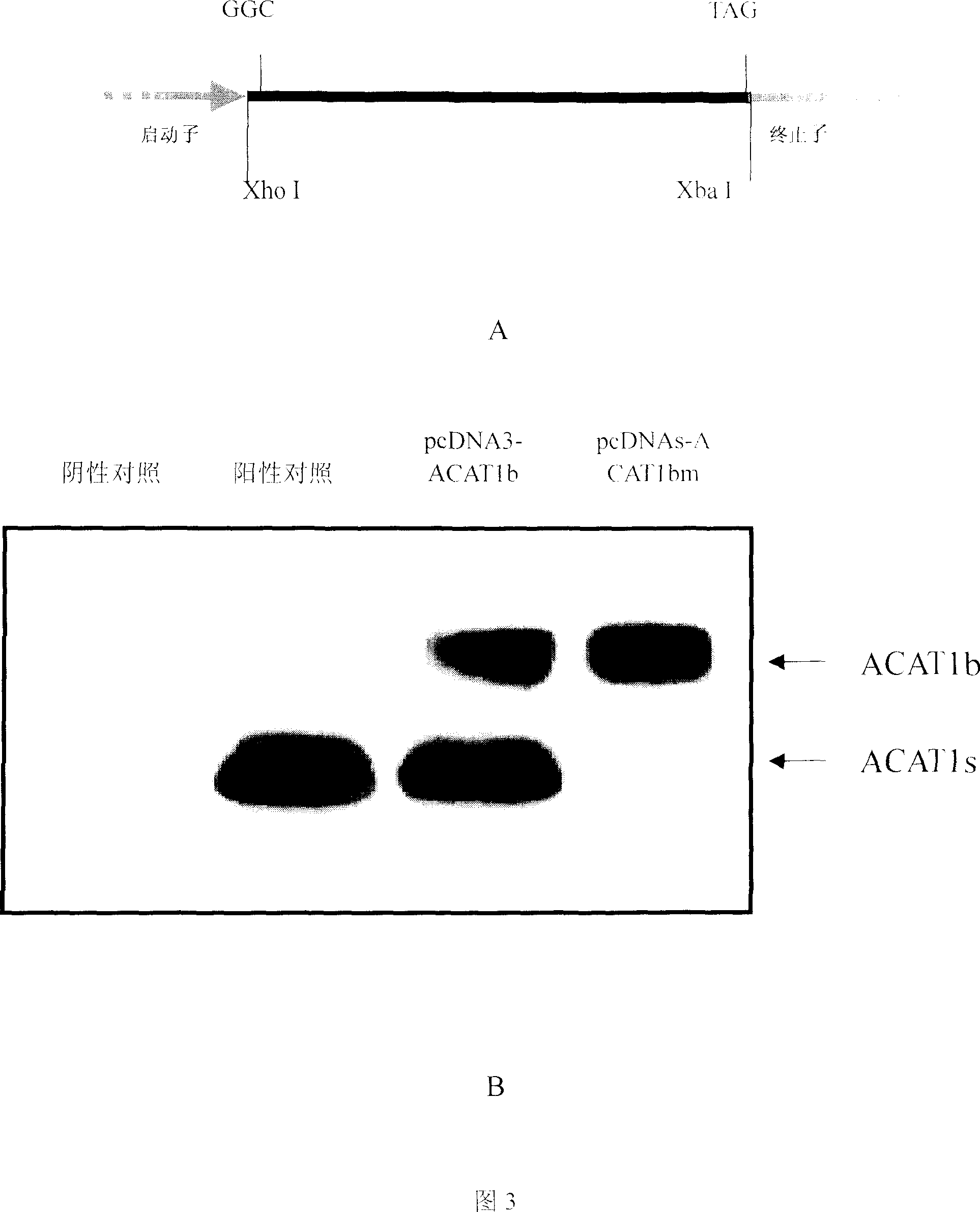Synthetase-1b for human cholesterol ester and coded sequence
A technology of cholesteryl ester and synthetase, which is applied in the direction of transferase, drug combination, peptide/protein composition, etc.
- Summary
- Abstract
- Description
- Claims
- Application Information
AI Technical Summary
Problems solved by technology
Method used
Image
Examples
Embodiment 1
[0075] Example 1 Cloning and identification of human ACAT1b cDNA
[0076] In order to obtain the cDNA sequence containing human ACAT1b, design synthetic primers, the sequence is as follows:
[0077] L1D2BF: 5'ACCGCTCGAGTAGTTAAATAG3'
[0078] H1T7C1: 5'AGGTCTAGAACAGCTGGCTCCAAAT3'
[0079] Using L1D2BF and H1T7C1 primers, the ACAT1 cDNA K1 sequence was amplified by PCR, and the PCR product was cloned into the XhoI and XbaI sites of pcDNA3 (purchased from Invitrogen), and the sequence was determined correctly. On this basis, it was found that the cDNA sequence had the function of encoding 591 amino acids of human cholesteryl ester synthase, and the inventor named it the ACAT1b gene sequence.
[0080] The measured nucleotide sequence of human ACAT1b cDNA is shown in Figure 1 and SEQ ID NO:1.
Embodiment 2
[0081] Example 2 Analysis of human ACAT1b cDNA reading frame and its encoded amino acid sequence
[0082] According to the ACAT1b cDNA sequence obtained by sequencing and a series of sequence mutation studies, it was found that the 5'-region of the cDNA sequence has a non-AUG (GGC) translation initiation codon, and the 3'-region has a TAG translation termination codon, indicating that this It is a gene cDNA sequence with an atypical translation reading frame, which encodes a 591 amino acid sequence of human cholesteryl ester synthase ACAT1b (Figure 2), which is 41 more amino acid residue sequences than human ACAT1s reported by foreign counterparts.
Embodiment 3
[0083] Example 3 Construction of human ACAT1b cDNA eukaryotic expression vector
[0084] In order to determine the protein expression and enzyme activity analysis of human ACAT1b cDNA, the coding region of the human ACAT cDNA K1 sequence reported earlier was used as a positive control; then, the obtained positive control and sample cDNA were respectively inserted into pcDNA3 (purchased from Invitrogene Company) between XhoI and XbaI, located downstream of the CMV promoter, to obtain the corresponding eukaryotic expression vectors: pcDNA3-A1s and pcDNA3-A1b (see Figure 3A map). In order to separate from the ACAT1s protein, a mutation was introduced into the corresponding codon in the ACAT1b cDNA, which was also inserted between XhoI and XbaI of pcDNA3, located downstream of the CMV promoter, to obtain the corresponding eukaryotic expression vector: pcDNA3-A1bm, so that it only ACAT1b was expressed (see Figure 3B for expression profile).
PUM
 Login to View More
Login to View More Abstract
Description
Claims
Application Information
 Login to View More
Login to View More - R&D
- Intellectual Property
- Life Sciences
- Materials
- Tech Scout
- Unparalleled Data Quality
- Higher Quality Content
- 60% Fewer Hallucinations
Browse by: Latest US Patents, China's latest patents, Technical Efficacy Thesaurus, Application Domain, Technology Topic, Popular Technical Reports.
© 2025 PatSnap. All rights reserved.Legal|Privacy policy|Modern Slavery Act Transparency Statement|Sitemap|About US| Contact US: help@patsnap.com



